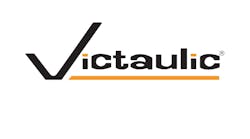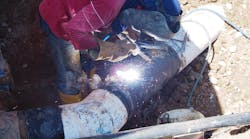Latest from Piping
Sponsored
In 2013, a water main broke in Los Angeles and flooded Nowita Place. The damage happened quickly, with gallons of water flooding the streets and eventually making its way toward businesses and residences. Locals in the area ended up without water for several hours as city officials worked to repair the issue. This example is one of many disasters that come with aging pipes.
Los Angeles is only one city in the United States, but this incident is a case study for what happens when water infrastructure reaches the end of its useful life. Leaks become the best-case scenario, and floods become more likely. The LA Times estimates that the city will need to spend $1 billion to replace aging waterworks.
The focus is on getting cities, communities and individual residents to understand the urgency of piping solutions. Utility and contractor customers could range from city officials to a landlord to a homeowner. Water infrastructure needs come in all shapes and sizes, especially when the pipes are old and pose a risk.
The damage to homes and businesses includes foundational harm and a potential buildup of hazardous substances like mold. On a citywide level, roads can buckle, sinkholes can form and floods can become more common. Aging pipes do indeed have that potentially devastating power and influence. The 2013 Los Angeles incident shows the destruction well.
Working with cities and homeowners can be difficult in this industry. Shutting off water is a nuisance to many and can cause customer satisfaction to drop. The added noise from repairs to the pipes can irritate residents as well. However, aging pipes are too critical to ignore—the time to solve these issues is now.
Replacing vs. Repairing
Back in 2017, the American Society of Civil Engineers Foundation’s Infrastructure Report Card gave the United States a D+ for overall water infrastructure and a D for drinking water—a grim wake-up call. With an ongoing water scarcity crisis throughout the world, the U.S. can’t afford to lack good piping as well—the costs add up too quickly.
Cities rely on these pipes to provide millions of residents with water for drinking, bathing, cleaning and more. In more suburban or rural areas, the water infrastructure branches out to individual homes and properties. Thus, with such low scores, it’s likely that plenty of locations around the country need repairs or replacements.
However, the dispersion of aging pipes around the U.S. can make replacement difficult. Utilities and contractors may have to shut off water access for prolonged periods, and the prices can turn some cities and residents away. Replacements can cost a resident hundreds or thousands of dollars and cost a city millions.
A more practical solution is to work on the pipes in parts. Repairs will suffice in some areas, but others will need radical restructuring. Finding the balance of satisfying customers and addressing the infrastructure’s needs can be a hassle, with contractors trying to maintain a positive track record.
Whether it’s a buildup of grime, pollutants, biofilm or sludge, a good cleaning may sometimes suffice. Other times, corrosive soil and old materials require complete replacements. As more pipes come to the end of their lifespans, working with customers and cities is preferable to working around them.
This first step toward balanced solutions requires understanding when it’s better to repair or replace aging pipes. Sometimes, though, a customer will be reluctant. This requires contractors to introduce better communication and awareness.
Conveying the Issues of Aging Pipes
The overall changes will be expensive, especially for cities. However, the alternative of doing nothing is not an option. Cities would have to spend millions of dollars, or even billions like in Los Angeles, to repair damage after a flood or rupture. It’s better to take a proactive approach when it comes to water infrastructure. Conveying this need is critical.
The COVID-19 pandemic has shifted priorities, and aging pipes may no longer be the most pressing concern for cities or homeowners. Water infrastructure ties in subtly, though. The pandemic has put an emphasis on health—pipes must be clean and efficient to ensure people stay well. Further, with more people working from home, residential water demand is going up.
The ultimate way for utilities and contractors to sell their services during the pandemic is to convey the focus on health as well as costs. The average water pipeline in America turned 45 in 2020—this aging is an eye-opening way to educate consumers of all backgrounds. A rupture or flood from pipes of this age will cost more than a repair or replacement.
On top of communicating the severity and raising awareness of the potential destruction, proactive and consistent contact are ideal. Officials and residents want to know what’s going on with their pipes, why the repairs must happen and how long it’s going to take. Maintaining communication and providing updates and progress reports will bring about better customer satisfaction. During this process, contractors should simultaneously focus on using new methods for replacing and repairing aging pipes for the best service.
Using New Technology
Technology has come a long way, and it’s evident in the water infrastructure industry. Aging pipes don’t have to remain outdated. Instead, utilities can use technology to ensure they are reliable and efficient while also providing consumers with more control and understanding of their water.
New materials have emerged in the current wave of pipe replacement and installation. Older items like iron and steel are still prominent, but they’re becoming less practical when plastics and prestressed concrete are available and cheaper upfront. Plastics can often have a shorter lifespan, however, which leads to more costs eventually.
One solution is using trenchless technology. Tools and methods include horizontal directional drilling (HDD), cured-in-place pipe (CIPP) and microtunneling. Trenchless procedures like these allow contractors to provide efficient, high-quality service without disturbing the environment by digging trenches and making loud noises. Trenchless capabilities put an innovative spin on fixing aging pipes and may be more appealing to customers.
New tools can be smaller and just as powerful, too. Businesses and industries are embracing the use of data to observe pipes’ performance and detect potential problems. Smart Internet of Things (IoT) technology will be invaluable to gather this information. IoT sensors can attach to the pipes and then monitor them over the years.
They can report information about leaks in real-time so contractors know exactly where the damage is, allowing them to act on it immediately to prevent any ruptures. IoT systems also help with predicting when maintenance is necessary. The software takes into account factors like soil conditions, pipe materials and age, weather, roadways and history of errors.
Similarly, water pressure monitoring and smart metering allow contractors and homeowners to see how much water they need, how much it will cost and the ability to contact help remotely if necessary.
Solutions on Every Scale
Using new technology is a key way to draw people in. Smart gadgets have become the norm—contractors must adapt. Aging pipes can be replaced before their expiration dates, and utility workers can focus on ensuring the water infrastructure in the United States improves. However, this feat must occur on every level, big and small, urban and rural.
The wastewater infrastructure is inherently part of the aging pipes dilemma. Households alone can waste 900 billion gallons of water every year in the U.S., and treating and recycling this resource must be an efficient process. Pipes play a critical role here as well. Leaks or unsanitary conditions make it impossible for treatment plant workers to efficiently recycle all wastewater.
The overall D+ and D scores that the U.S. received for its water infrastructure includes wastewater treatment. To get a better system in place, plant workers and contractors must work cooperatively to fix aging pipes. This process will be relatively similar to working with individual residents. Awareness and education are the keys to moving forward.
Then, the water infrastructure can improve on all levels. Cities and rural areas alike will see improvements, as will individuals. The nation will then waste less water with a better piping system in place that wastewater treatment plants ultimately facilitate.
Solving the Aging Pipes Dilemma
Water infrastructure is a systemic issue. It spans across neighborhoods and terrains and from coast to coast. Sooner or later, it will affect everyone in the country. The solution is to take it step by step while balancing water needs and customer expectations.
Contractors must first understand which areas need repairs or replacements the most. Then, with convincing education, they can get more residents and city officials on board. Working with the latest technology allows new materials and systems to adapt to consumer needs, ultimately creating a win-win scenario for everyone throughout the process.
Rose Morrison is a freelance writer who covers construction, home improvement, and contracting topics. She is also the managing editor of Renovated.com, a site dedicated to the latest trends in the home industry. She has a passion for innovative technologies that are making the home industry sustainable and efficient. Check out Renovated.com to see more of her work.

Rose Morrison
Rose Morrison is a freelance writer who covers construction, home improvement, and contracting topics. She is also the managing editor of Renovated.com, a site dedicated to the latest trends in the home industry. She has a passion for innovative technologies that are making the home industry sustainable and efficient. Check out Renovated.com to see more of her work.


